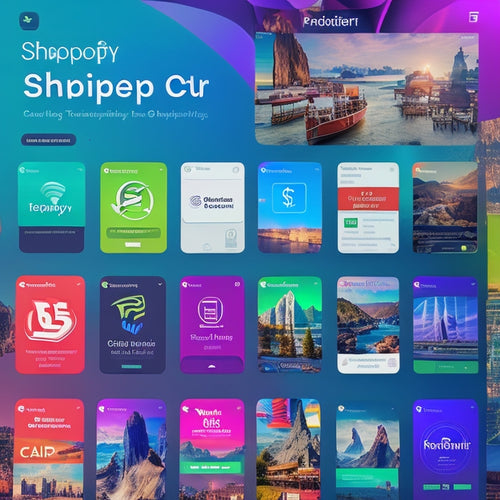
Streamline Online Payments: Gateway Integration Simplified
Share
You're integrating a payment gateway to secure online transactions and protect sensitive customer data. First, you need to understand the payment gateway's role in processing transactions, guaranteeing authorization, capture, sale, refund, and void. Next, you'll navigate the payment processing flow, where customer data is encrypted and sent to your server, then connected with card networks and issuer banks. To simplify integration, you'll assess four primary integration methods, balancing flexibility, security, and regulatory alignment. Now that you've started streamlining online payments, you'll discover how to ensure PCI DSS compliance and select the right payment gateway provider to meet your business needs.
Key Takeaways
• Implement a secure payment gateway to ensure seamless and protected online transactions.
• Choose an integration method that balances flexibility and security, considering regulatory alignment and user experience.
• Prioritize PCI DSS compliance, implementing strong security measures and regular vulnerability scans to prevent cyber threats.
• Evaluate payment gateway providers based on pricing, transaction limits, merchant account options, and integration features that meet business needs.
• Simplify online payments by selecting a provider that offers a user-friendly interface, streamlined checkout process, and reliable technical support.
Understanding Payment Gateway Basics
When setting up an online store or accepting payments on a website, you'll need a payment gateway to authorize and process transactions securely and efficiently. A payment gateway acts as a secure portal between you and your customers, handling various transaction types like authorization, capture, sale, refund, and void.
One of the primary payment gateway benefits is the secure transfer of sensitive transaction data between your website or app and payment processors or banks. Payment gateway security is also a top priority, as it guarantees that customer data is protected from fraud and unauthorized access.
Navigating the Payment Processing Flow
Processing online payments involves a complex sequence of events, with your customer's payment information being verified by multiple financial institutions before the transaction is finalized. To enhance efficiency and boost security, comprehending the payment processing flow is crucial. Here's an overview:
| Step | Description | Responsibility |
|---|---|---|
| 1 | Customer submits payment info | Customer |
| 2 | Data is encrypted and sent to merchant's server | Merchant |
| 3 | Payment processor connects with card networks and issuer banks | Payment Processor |
| 4 | Issuer bank approves or denies request | Issuer Bank |
Choosing the Right Integration Method
You must carefully assess four primary integration methods, each varying in compliance and user experience levels, to determine the best approach for your business.
When selecting an integration method, consider the trade-offs between integration flexibility and security measures. Some methods offer more flexibility but may compromise on security, while others prioritize security but limit flexibility.
Additionally, think about the user experience you want to provide and guarantee regulatory alignment. For example, do you desire a seamless checkout process or a more secure, though potentially more intricate, payment flow?
Ensuring PCI DSS Compliance
Having chosen an integration method that aligns with your business needs, it's now important to verify that your payment gateway setup complies with the Payment Card Industry Data Security Standard (PCI DSS) to safeguard sensitive customer information.
You must meet compliance requirements by implementing strong security measures to protect data. Conducting regular vulnerability scans by approved vendors is essential to identify potential weaknesses. This guarantees your system is fortified against cyber threats.
Selecting a Payment Gateway Provider
When evaluating payment gateway providers, businesses must carefully weigh factors such as pricing, transaction limits, and merchant account options to guarantee seamless integration with their online payment systems.
You should conduct a thorough provider comparison, considering the unique features, pricing structures, and international support offered by popular providers like Stripe, PayPal, and Authorize.net.
Assess the integration features that align with your business needs, such as support for necessary payment methods and mobile payments.
Verify the provider's security measures meet PCI DSS compliance standards, safeguarding sensitive customer data.
Frequently Asked Questions
What Is the Typical Timeframe for Payment Gateway Setup and Integration?
When setting up a payment gateway, you'll face integration challenges, but with a clear implementation timeline, you can expect a typical setup to take around 2-4 weeks, depending on the complexity of your requirements.
Can Multiple Payment Gateways Be Used in a Single Online Store?
As you navigate the complex landscape of online payments, you're like a sailor charting multiple courses - yes, you can use multiple payment gateways in a single online store, but beware of integration challenges and carefully consider payment gateway selection to guarantee a secure and seamless experience.
How Do Payment Gateways Handle Recurring or Subscription-Based Payments?
You use payment gateways that support subscription management, ensuring secure recurring transactions. They handle subscription-based payments by storing sensitive card data, automatically processing repeat transactions, and providing robust security measures to protect customer information.
What Kind of Customer Support Do Payment Gateways Usually Offer?
'As you navigate the complex world of online payments, you'll find that payment gateways typically provide you with 24/7 support, offering swift troubleshooting assistance to guarantee seamless transactions and peace of mind.'
Are Payment Gateways Compatible With Various Website Platforms and Cms?
You'll find that payment gateways are generally compatible with various website platforms and CMS, allowing seamless integration through APIs, plugins, or modules, ensuring secure and efficient transactions across popular platforms like Shopify, WordPress, and Magento.
Related Posts
-

How Do I Optimize My Shopify Image for SEO
This article aims to provide informative and concise guidance on optimizing Shopify images for SEO purposes. Image o...
-

Unlocking Revenue Potential: Join the Shopify App Store Revenue Share Plan
The Shopify App Store has implemented a new revenue share plan for its partners, aimed at unlocking their revenue po...

